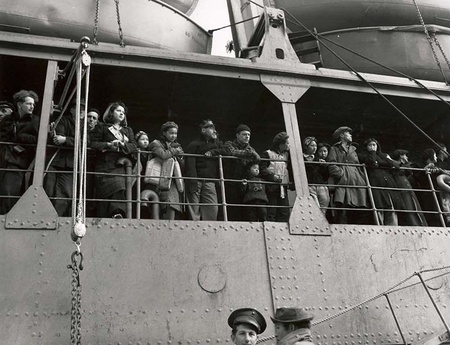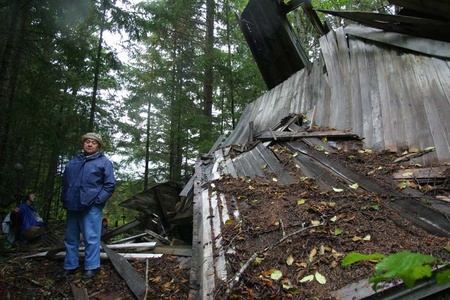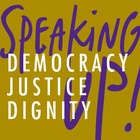“I just want it to go in the history books.”
—Mary Bourdukofsky, Aleut American internee
The reach of empathy is determined in part, I believe, by the sharing of memories. As much as our individual natures and experiences, inherited perceptions of the world around us shape our responses to both historical and contemporary events.
Who we were influences who we are—and how well we relate as members of a larger society.
But what if our memories are lacking?
Hired to produce a short film documenting the restoration of six Russian Orthodox churches in Alaska, I asked an obvious question: “What’s so important about these particular churches?” I expected an answer crammed with architectural details. Instead, I was told the story of an incredible civil rights struggle ignored by the history books, absent from our collective memory.
In 1942, as World War II invaded Alaska, Aleut Americans were taken by the United States government from their homes in the Aleutian and Pribilof islands and removed to abysmal “duration camps” some 1,500 miles away.

As World War II invaded Alaska in June 1942, 881 Aleut Americans - or Unangax - were ordered from their homes and onto cramped military transport ships bound for rotting "duration camps" some 1,500 miles away. The terrible conditions on-board were exceeded only by conditions in the camps, where 10 percent of evacuees would die due to disease and neglect. (National Archives, General Records of the Department of the Navy.)
The federal camps were dark and dank, mired in the coastal muck of Southeast Alaska’s rainforest. Hastily converted from a rotting fish cannery and abandoned gold mine, an aging herring saltery, and an unused Civilian Conservation Corps site, the camps had no running water, no heat, no privacy. Blankets, food, and medical care were in short supply.
Death was ever-present. An estimated 10 percent of the men, women, and children sent to the camps would die there—a death rate comparable to that suffered by Americans in foreign prisoner of war camps.
And as Aleuts prayed for deliverance, so-called “friendly forces” looted their homes and churches in the Aleutian and Pribilof islands.
Those who survived would fight for their rights—in the nation’s courts and on Capitol Hill. In a historic action, Aleuts joined Japanese Americans seeking wartime reparations from the federal government. But the Aleuts’ story remains all but unknown, even to Nikkei Americans.
The six week, $60,000 job became a five year, $850,000 documentary project about the Aleut American internment. The resulting 90-minute film, Aleut Story, was produced with SprocketHeads, LLC and the Aleutian Pribilof Islands Restitution Trust. I’ll be discussing the film at the upcoming 2013 Japanese American National Museum-sponsored national conference Speaking Up! Democracy, Justice, Dignity, in Seattle, Washington on July 4–7, 2013. Part of the Basic Introduction series, the conference session “World War II and Redress Experience of Japanese Alaskans and Aleuts” is scheduled for Saturday, July 6, from 11:00 a.m. to 12:15 p.m.
A record of government neglect, and abuse
Ancestors of modern Aleuts—also known as Unangan—migrated to Alaska an estimated 10,000 years ago from Asia, settling in the far-flung Aleutian Islands, a volcanic archipelago reaching between the Bering Sea and the Pacific Ocean. In the late 1700s, Russian explorers and fur traders arrived in the islands and quickly began a brutal campaign for control of the Aleuts and their natural resources, mainly fur seal. In 1867, when the United States bought Alaska, Aleuts were granted U.S. citizenship under terms of the purchase. Extensive government logs document U.S. policy in the islands, including control of virtually every aspect of Aleut life.
During the making of the film, I reviewed tens of thousands of pages of historical documents, public testimony, congressional debate, personal memoirs, photographs, and scholarly texts. Many of these documents appear in the film or are available on the companion website (www.aleutstory.tv). But the real strength of this film are the Aleut American voices, resonating across time and distance. Their unflinching accounts lend an inexpressible eloquence to the film.
“My little brother, Baby Sergei, he was three months old when he got double pneumonia. But the government nurse at the camps said there was nothing we could do for him,” recalls Vlass Shabolin, during filming at the site of the former duration camp at Funter Bay, on Admiralty Island, near Juneau, Alaska.
“My mom took him to the midwife and she told her to keep him warm. But where we lived, we only had a 55-gallon drum to warm up something like a 40 [foot] by 80 [foot] cannery. My mom and the midwives tried their best to get him healthy, but they couldn’t and he just cried and cried.
“He died in my mom’s arms. So they went and got the priest; the priest came over and gave a blessing to the child. Next day the carpenters were down at the shop, making a little coffin for him.”
Shabolin was five years old when his brother died. He would lose more family at the camp. Picking his way through the wreckage of the bunkhouse where his family spent two-and-a-half long years, Shabolin says quietly, “Those were the hardest childhood days I had.”

Vlass Shabolin was five years old when his family was ordered from their home on St. Paul Island, Alaska and sent to a federal duration camp 1,500 miles away. Returning to Funter Bay during the filming of the public television documentary "Aleut Story," Shabolin stands alongside a rotting bunkhouse and recalls his childhood days in the camp -- the hunger and loss, including the death of his baby brother. (Photo: "Aleut Story," www.aleutstory.tv. Directed by Marla Williams, Produced by Sprocket Heads and Aleutian Pribilof Islands Restitution Trust, Presented by Native American Public Telecommunications, Distributed by American Public Television.)
Technically, the Aleuts were not prisoners, but neither were they free to leave the camps. Those who left or attempted to leave were told by federal agents that they would be permanently banished from their homes in the Aleutian and Pribilof islands.
Executive Order 9066, President Franklin D. Roosevelt’s infamous decree setting in motion the incarceration of nearly 120,000 Americans of Japanese ancestry, did not expressly apply to Aleut Americans. But America’s wartime policies in 1942, together with institutional racism against indigenous Americans, set the stage for the forcible removal and confinement of the Aleuts.
The Aleuts’ loyalty to the United States was never in question—only their value as human beings. Government directives, such as E.O. 9066, combined with decisions clouded by paternalism, racism, and political jealousy, effectively stripped the Aleuts of their rights as U.S. citizens.
Some in government believed the Aleuts needed, like children, to be confined in the camps for their own good, safe from drink and debauchery. “These people could never adjust themselves to life outside” the islands, wrote one federal territory official.
Other officials had more mercenary motives: for decades, the Aleuts had worked as virtual indentured servants in the federally controlled and highly lucrative fur-seal harvest, and government agents didn’t want to lose control of their labor force.
“The Government owned us and they treated us as property,” says Flore Lekanof, who was 17 when his family was herded aboard the military transport U.S.S. Delarof and taken from St. George Island to Funter Bay. “People learned that they weren’t being treated as full citizens.”
We all have rights
I did a lot of research at senior centers in the Aleutian and Pribilof islands, which always have hot coffee, fresh cookies, and room for one more at lunch.
Many survivors hadn’t spoken of the camps in 60 years, their humiliation and loss too great. Unable to believe their country would betray them without reason, some Aleut internees felt they were somehow to blame. Most were simply too busy reclaiming and rebuilding their lives, their community, their culture—and their rights.
So we started off, over hot casseroles and Jell-O salads, talking about arthritis. I’ve never been so happy to have arthritis, the generational and cultural distance between us considerably lessened by discussions of gnarled hands, aching knees, and ineffective treatments. Our pain was a reminder that we had a lot in common—chiefly, we’re all human beings.
Americans argue a lot about how much government should do for its citizens. It was not different at the senior centers. The one thing everyone could agree on was that government fails its citizens when it ignores or denies the basic rights all humans crave—and our constitution guarantees.

Mary Boudukofsky was a young mother of two, with a third child on the way, when she was removed from St. Paul Island to the federal "duration camp" at Funter Bay, Alaska. Conditions at the Funter Bay, and other camps where the Aleut (Unangax) were sent were shocking. Returning to Funter Bay decades later, during the filming of the documentary "Aleut Story," Mary joins her son, Peter (left), born at the camp, and fellow internees Flore Lekanof (immediate right of Mary) of St. George Island, and Vlass Shabolin of St. Paul Island in a prayer of remembrance for all those who suffered and died here. (Photo: "Aleut Story," www.aleutstory.tv. Directed by Marla Williams, Produced by Sprocket Heads and Aleutian Pribilof Islands Restitution Trust, Presented by Native American Public Telecommunications, Distributed by American Public Television.)
Mary Bourdukofsky had two small children and a third on the way when she was sent to Funter Bay. She passed away recently, but in the years I knew her she lived fully in the present tense. She only agreed to revisit the past to protect the future. “What happened to us shouldn’t have happened to anybody,” she says. “Maybe if I tell my story it will help remind people Americans need to stand up for each other.”
Returning to Funter Bay, Mary recalls feelings of confusion, despair, and outrage. “Finally, we all got together and had a meeting and then we wrote this letter,” she says, holding a copy of a 1942 petition to the U.S. Department of Interior, which was responsible for the Aleuts’ care in the camps. “I’ll read it: ‘We the people of this place want some better place than this to live. This place is no place for living creatures … Why they not take us to a better place to live and work for ourselves? Do we have to see our children suffer? We all have rights to speak for ourselves.’”
“One of the problems was that the Aleuts weren’t really respected as individuals,” says Angus Macbeth, special counsel to the Commission on Wartime Relocation and Internment of Civilians, the federal blue-ribbon panel convened in 1980 to investigate the World War II “relocation and internment” of persons of Japanese ancestry and the Aleuts. “And, it had terrible, terrible costs for a great many of the Aleuts.”
Whaler’s Cove Lodge, a high-end fishing lodge, now occupies the ground where Killisnoo duration camp stood. You won’t find any mention of the Aleut confinement in the lodge history. But if you hike back into the woods behind the lodge you may find the graves of Aleut Americans who died. You have to look closely; many of the small crosses marking the children’s graves are all but lost in nettles and dense underbrush.
I visited Killisnoo with Alice Petrivelli who, at 12, watched U.S. forces burn her Aleutian village to the ground before its residents were herded onto a transport ship and taken to the camp.
Sitting on an overturned dinghy behind a boat shed at Killisnoo, speaking between long drags on a cigarette, Petrivelli talked about how the dead are casualties of an indifferent nation.
Petrivelli smoked a lot then; she’s since cut back on cigarettes and lost a lot of weight. She says telling the story was like shedding an old skin, making it possible to give up some old habits.
She still talks, though, of how her own daughter, born several years after the evacuation and internment, refused to believe it happened.
“I was telling Patricia about her Aleut family…about how hard life was in the camp, and she looked at me and said, ‘Mama, are you sure it happened?’
“I said, ‘Yes, it actually happened.’”
“‘But it’s not in the history books,’ she said.”
“She didn’t believe me,” Petrivelli says. “Most people didn’t.”
Protecting our democratic ideals
The Aleuts understandably lost faith in government, but they continued to hold fast to democratic ideals. Abandoned by their country, they would not give up on their countrymen. And that is the part of the story that really grabbed me, that took hold of all the people—famous and not-so-famous—who agreed to work on the film.
Aleuts who survived the camps returned home to wage a decades-long campaign for democracy. It was a historic undertaking with one, over-arching goal: That their story become part of the history books—so future generations of Americans would not suffer the loss of their civil and human rights as had the Aleuts.
After months of review, the Commission on Wartime Relocation and Internment of Civilians determined there was no military necessity or any other doctrine to justify the Aleuts’ confinement. The government had, “as a matter of simple convenience, segregated the Aleuts, limited their personal freedoms and managed them as a herd of animals.”
The commission concluded, “The removal of the Aleuts and Pribilof Islanders from their homes, with the destruction of their communities and churches, was…an American tragedy.”
The Aleuts’ story is a quintessential American story, with lessons of great consequence for our democratic culture. If the ideals of liberty and equal justice for all—pillars of our republic—are to remain strong, we must remember what the Aleuts learned so painfully six decades ago.
On a windy hill above the Aleutian village of Unalaska is a stone monument with the words: “Eternal vigilance is the price of freedom.” It is a reminder, etched in stone, that we all have a part in the Aleuts’ story:
Democracy is fragile and only by maintaining individual rights, even in times of stress, will this nation endure. Only a citizenry knowledgeable about its past, both glorious and inglorious, can prevent the recurrence of egregious mistakes.
About the Film
ALEUT STORY is produced by the Aleutian Pribilof Islands Restitution Trust and SprocketHeads, LLC, presented by Native American Public Telecommunications, and distributed by American Public Television. Major funding generously provided by the Rasmuson Foundation, Aleutian Pribilof Islands Restitution Trust, and the Paul G. Allen Family Foundation, with additional funding from the Hugh and Jane Ferguson Foundation, the Henry M. Jackson Foundation, and people like you.
ALEUT STORY may be seen on public television stations nationwide; check local listings or contact your local public television station. The 90-minute documentary may also be viewed at no-cost, in its entirety, online at www.snagfilms.com/films/title/aleut_story. Copies of the film are available for purchase for home and educational use from www.visionmaker.com
For more information, please visit www.aleutstory.tv
* * *
* Marla Williams will be speaking at the “World War II and Redress Experiences of Japanese Alaskans and Aleuts” session at JANM’s National Conference, Speaking Up! Democracy, Justice, Dignity on July 4-7, 2013 in Seattle, Washington. For more information about the conference, visit janm.org/conference2013.
© 2013 Marla Williams




